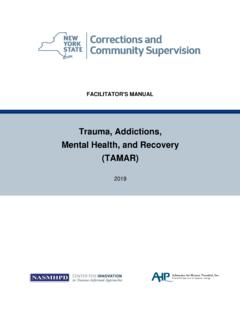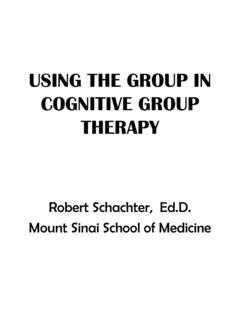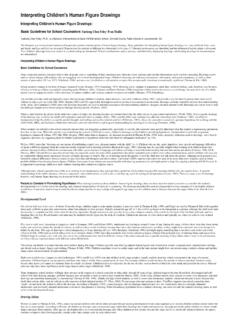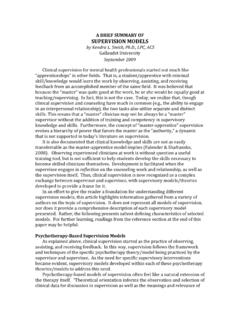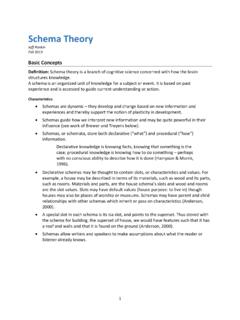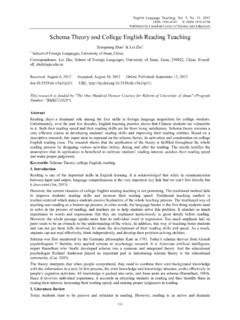Transcription of Cognitive Behavioral Therapy for Psychosis (CBTp)
1 FACT SHEET Cognitive Behavioral Therapy for Psychosis (CBTp) AUTHOR: KATE HARDY, Stanford University Department of Psychiatry and Behavioral Health CBT helps individuals become aware of their thoughts and behaviors, with a focus on exploring how these impact their emotions. What is Cognitive Behavioral Therapy ? Cognitive Behavioral Therapy (CBT) is an evidence-based talking Therapy that concentrates on how an individual s thoughts, behaviors, and emotions are connected. CBT helps individuals become aware of their thoughts and behaviors, with a focus on exploring how these impact their emotions. The here and now focus allows for the development of skills to identify and address unhelpful thinking patterns and behaviors.
2 As part of CBT, formulation (or case conceptualization) allows for the exploration of past experiences to gain an understanding of: how predisposing factors may have underpinned the current links between experiences, thoughts, emotions, and behaviors; and how that increases the individual s vulnerability to developing mental health problems. Technical Assistance Material Developed for SAMHSA/CMHS under Contract Reference: HHSS283201200002I/Task Order No. HHSS28342002T Cognitive Behavioral Therapy for Psychosis (CBTp) Cognitive Behavioral Therapy for Psychosis (CBTp)2 CBT is recommended as a first-line intervention for the treatment of mild to moderate depression and anxiety (NICE, 2014) and as an adjunct to medication management in the treatment of more serious mental health problems.
3 CBT is a structured Therapy with sessions that follow a similar course and outline regardless of the presenting problem. This outline includes: a review of the week; development of an agenda for the session; review of homework; Cognitive and/or Behavioral skill acquisition related to an identified problem area; and, finally, setting homework so that the client can practice these new skills in their own environment. The therapist may summarize the session or ask the client to do so and will request feedback so that subsequent sessions can be tailored to fit with what the client found most helpful. Adaptations to this format may be required depending on the client population. Table 1 shows a list of the key features of CBT (Beck, 1995).
4 TABLE 1: Key features of CBT Collaborative with active participation Builds on a strong therapeutic alliance Structured Time limited Goal and recovery oriented Formulation driven Draws upon a variety of Cognitive and Behavioral techniques Generalization of skills through homework What is Cognitive Behavioral Therapy for Psychosis ? Psychosocial interventions were long overlooked as a treatment for Psychosis . Cognitive Behavioral Therapy for Psychosis (CBTp) was initially developed as an individual treatment, and later as a group-based intervention, to reduce the distress associated with the symptoms of Psychosis and improve functioning. Studies have demonstrated that CBTp can result in decreased positive symptoms, improvement in negative symptoms, and improved functioning (Wykes et al.)
5 , 2008; Burns et al., 2014; Turner et al., 2014, van der Gaag, Valmaggia & Smit, 2014). In addition, there is evidence to suggest that CBTp can be effective in preventing, or delaying, the transition to full Psychosis when used with individuals identified as being at risk of developing Psychosis (Stafford et al., 2013). From these studies, CBTp has emerged as an evidence-based intervention recommended as an adjunct to medication management (Dixon et al., 2010; NICE 2013; NICE 2014). Different treatment protocols exist, and recently the field has moved toward delineating different levels of CBTp treatment. These include: Full CBTp, defined as the intention to provide 16 or more one-to-one sessions over at least six months by a CBT therapist (a therapist with CBT background/ Cognitive Behavioral Therapy for Psychosis (CBTp)3 qualification and additional CBTp training) for example, formulation-driven CBTp (Morrison, 2017); CBT-informed interventions, defined as interventions provided by mental health practitioners not meeting the criteria of a full CBTp therapist, such as Coping Strategy Enhancement (Tarrier et al.
6 , 1993) and nurse-delivered CBT-informed interventions (Turkington, Kingdon, & Turner, 2002); Targeted CBTp interventions, targeting clearly specified mechanisms with a CBTp therapist, such as Worry Intervention (Freeman et al., 2015), AVATAR Therapy (Leff et al., 2014), Cognitive Therapy for Command Hallucinations (Birchwood et al., 2014), and Individual Resiliency Training (Penn et al., 2014). CBTp is grounded in the guiding principles of CBT. However, Brabban et al. (2016) propose that three features have emerged as essential: 1. The collaborative development of a shared formulation to inform the understanding, and maintenance, of psychotic symptoms and to aid in making sense of these experiences 2. Normalization of the psychotic experience to address the stigma that often is associated with Psychosis 3.
7 Acceptance of psychotic symptoms, which highlights the primary goal of this approach to reduce distress relating to the symptoms, rather than attempting to alter the occurrence of the symptoms. CBTp typically progresses through the following phases: 1. Engagement and befriending Brabban et al. (2016) emphasize the importance of the therapeutic relationship in CBTp, arguing that this feature is an essential aspect of the approach while also a preference prioritized by consumers. This phase may occur over an extended period if a consumer is reluctant to engage in Therapy , has had previous negative experiences with mental health providers, or is experiencing symptoms that impact their ability to engage in a therapeutic relationship, such as paranoia.
8 During this phase, the client will be supported to identify the key issues with which they are currently struggling in the form of a problem list and to develop corresponding goals to aid in their recovery. 2. Assessment of experiences CBTp requires the clinician to support clients in exploring their symptoms while also sitting on the collaborative fence. This is defined as a collaborative exploration of these experiences, with the therapist dropping the expert role and assumptions that they might hold about these symptoms, as well as being open to multiple possible explanations. By doing this, the therapist is modeling flexibility in thinking, openness to alternate explanations, and collaboration. 3. Formulation development The formulation aims to help the client, and his/her therapist, gain a better understanding of the links between the client s early experiences, core schema , Cognitive Behavioral Therapy for Psychosis (CBTp)4 unhelpful thinking patterns, and maintenance of current symptoms.
9 Importantly, the formulation informs intervention since it highlights changes that may need to take place to address distressing symptoms. Figure 1 shows a maintenance formulation as an example. This type of formulation helps the client understand the link between their interpretation of the event and subsequent Behavioral and affective responses, and in particular highlights the role that the interpretation and behavior have in maintaining the emotion. EMOTIONS BEHAVIOR EVENT INTERPRETATION Figure 1 4. Application of intervention and skill building Drawing upon the formulation, and in collaboration with the client, interventions are developed that address issues identified by clients in their problem list in order to support them in achieving the goals established at the beginning of Therapy .
10 A range of Cognitive and Behavioral interventions exist that have been developed to target specific psychotic symptoms. These include, but are not limited to, coping skills for managing voices, exploring the evidence for unusual and distressing beliefs, and increasing functioning by addressing negative symptoms. 5. Consolidation of skills Since CBTp is a collaborative Therapy , it requires the active participation of the client within the session as well as between sessions. This allows the client to actively test the skills discussed in session in the real world and to provide feedback to the therapist on the efficacy of the intervention, allowing for adaptation where necessary. Ultimately, the aim is to support the client to become their own CBTp therapist by teaching them the skills outlined above.


